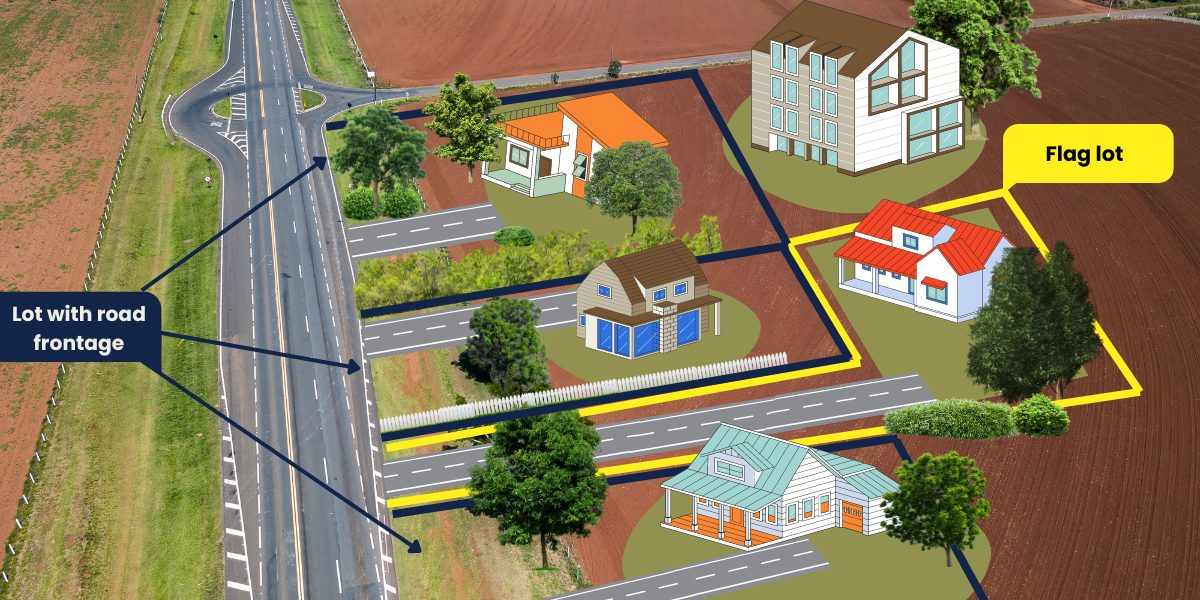Flag Lot: What Is It And What Are The Key Considerations?
Updated Thu, Oct 23, 2025 - 8 min read
Top blog articles
In real estate, there are all sorts of different lot shapes and layouts. But one that often puzzles people is something called a flag lot. It’s an interesting configuration that differs from the standard plots you might be familiar with in suburban or urban neighborhoods. So, what is a flag lot, and why might someone want one? Let’s find out.
What Is a Flag Lot?

The name “flag lot” originates from the resemblance of the property’s layout to a flag on a flagpole. Imagine a large rectangle or square (the flag) set back from the street, connected by a narrow strip of land (the pole) that gives it access to the road. This narrow strip is known as the street frontage, the part of the lot that touches the public street or road, allowing cars or people to enter the property.
The wider portion of the lot, where a house or other structures would be built, is set back from the road, typically behind other properties.
That’s why a flag lot is often referred to as a panhandle lot or a flagpole lot. According to municipal planning guidelines, these unique configurations have specific requirements for access strip width, typically ranging from 12 to 50 feet, depending on local regulations.
Why Are Flag Lots Created?
This shape is often due to subdivision or land use regulations intended to maximize land use while preserving privacy or addressing specific zoning requirements.
When someone owns a large parcel of land, especially in a rural area, they might divide it into smaller lots to sell. However, if there isn’t enough street frontage for each of the smaller lots, the solution is to create flag lots. These lots allow the owner to divide the land in a way that maximizes usable space while still providing access to the road.
Flag lots are more common in rural areas, where large tracts of land are plentiful, and subdivisions are more frequent. When a property owner wants to divide a large piece of rural land, flag lots allow them to sell individual lots with enough space for a house and possibly some additional land for farming, gardening, or other uses.
Urban planning experts note that flag lots can also be found in more developed areas when large plots are subdivided into neighborhoods on the outskirts of cities. They make use of space that would otherwise remain landlocked or inaccessible, thus creating development opportunities where none might have existed before.
What to Consider Before Investing in Flag Lots
One thing to consider with flag lots is the overall lot size. Flag lots can vary significantly in size, depending on how the land is divided. The narrow strip of land that provides access is usually not counted toward the total buildable area. It means the usable portion of the lot must be large enough to accommodate the buyer’s needs, whether that’s a single-family home or something larger.
Because flag lots are often irregularly shaped, they might present some challenges in terms of planning and construction. The shape of the lot can affect the placement of a house, driveway, and other features. It’s important for potential buyers to understand exactly what they’re working with and to ensure that the flag lot’s lot size is sufficient for their intended use.
According to municipal zoning codes, flag lots may only be created through proper subdivision processes and often require conditional use permits, especially in areas with topographic challenges or when multiple flag lots are proposed.
What Are the Pros of Having a Flag Lot?
Privacy: One of the main advantages of a flag lot is increased privacy. The positioning of the house at the rear of the lot, away from the street, provides a buffer from noise and prying eyes.
Reduced street noise: Since the house is set back from the street, flag lots often experience less street noise compared to properties located directly on the road.
Enhanced security: Flag lots can offer an added layer of security since the house is not directly accessible from the street. The longer driveway acts as a natural barrier, making it more difficult for unauthorized individuals to reach the property.
Larger backyard: Flag lots typically have larger backyards since the house is situated toward the rear of the lot. This can provide more outdoor space for gardening, landscaping, or recreational activities.
Potential for better views: Depending on the layout and elevation, flag lots may offer better views compared to properties located on the street. The increased distance from the road can provide unobstructed views.
What Are the Cons of Having a Flag Lot?
Limited street frontage: Flag lots have a narrow access point or driveway leading to the main road. This limited street frontage can impact accessibility and may restrict the size and style of structures that can be built.
Potential for restricted parking: The longer driveway of a flag lot may limit the availability of parking spaces, especially if the lot size is small. This can be a concern when hosting guests or if there are multiple vehicles in the household.
Reduced visibility: Some people may view the secluded nature of flag lots as a disadvantage. The house being set back from the street can make it harder to find or give a sense of seclusion that some may find undesirable.
Challenges with utilities and services: Depending on the location and infrastructure, flag lots might face challenges in accessing crucial utilities such as electricity, water, and sewage. Extending these services to the rear of the lot can involve additional costs or logistical issues.
Emergency access concerns: Local fire departments often have specific requirements for flag lot driveways, including minimum widths to accommodate emergency vehicles and turnaround areas. These requirements can add to development costs.
Potential resale challenges: Flag lots might have a more limited appeal to certain homebuyers. Some individuals may prefer properties that are easily accessible from the street or have a more traditional layout. This could potentially affect the resale value or marketability of a flag lot property.
Is a Flag Lot Right for You?

If you’re looking for a little more privacy, don’t mind a unique house layout, or are searching in a rural area where land might be divided into different shapes, a flag lot could be a great option. Just be sure to carefully consider the lot size, the access point, and any potential zoning or building restrictions before making a purchase.
Flag lots can be a practical and affordable solution in the right context, but they do require a bit more planning and thought than your average piece of land. According to the U.S. Department of Housing and Urban Development, properties seeking FHA financing must meet specific access and durability standards, which can be particularly important for flag lot configurations.
FAQs
What is street frontage, and why does it matter?
Street frontage is the part of a property that touches the street, giving you access to it. This is especially important for flag lots because, without it, the property would be “landlocked” and you wouldn’t be able to build on it or legally access it. Most jurisdictions require minimum street frontage ranging from 20 to 100 feet, depending on zoning regulations.
Is a flag lot cheaper than a regular lot?
Flag lots can sometimes be cheaper than regular lots because their odd shape and limited access might make them less appealing to some buyers. However, the price really depends on the location and local demand. In rural areas where privacy is valued, flag lots may actually command premium prices.
Can I build a house on a flag lot?
Yes, you can build on a flag lot as long as it meets your area’s zoning and building rules. Just be sure to check requirements like lot size, street frontage, and access to utilities before making any plans. You’ll also need to ensure compliance with local fire codes for emergency vehicle access.
What types of homes work best on a flag lot?
Flag lots are usually great for single-family homes. Their unique shape gives you flexibility in designing the home, and the extra privacy makes them ideal for custom-built homes or for people looking for a quiet, tucked-away spot. Some buyers specifically seek out flag lots for the seclusion they provide.
Are flag lots harder to sell?
Sometimes, flag lots can be a bit trickier to sell since their layout and access aren’t as conventional. Some buyers might prefer a regular lot with full street access, but others might like the added privacy and potentially lower cost. Working with a real estate agent experienced in unique property configurations can help overcome marketing challenges.
Do flag lots have the same utilities as regular lots?
In most cases, flag lots have access to the same utilities as other lots. However, if the property is set far back from the road, you might need to do some extra planning to get those services to the house. Extending utility lines through the access strip can add $5,000 to $20,000 or more to development costs. It’s a good idea to check with local utility providers and factor in any extra installation costs.
Your opinion matters. Leave a comment









